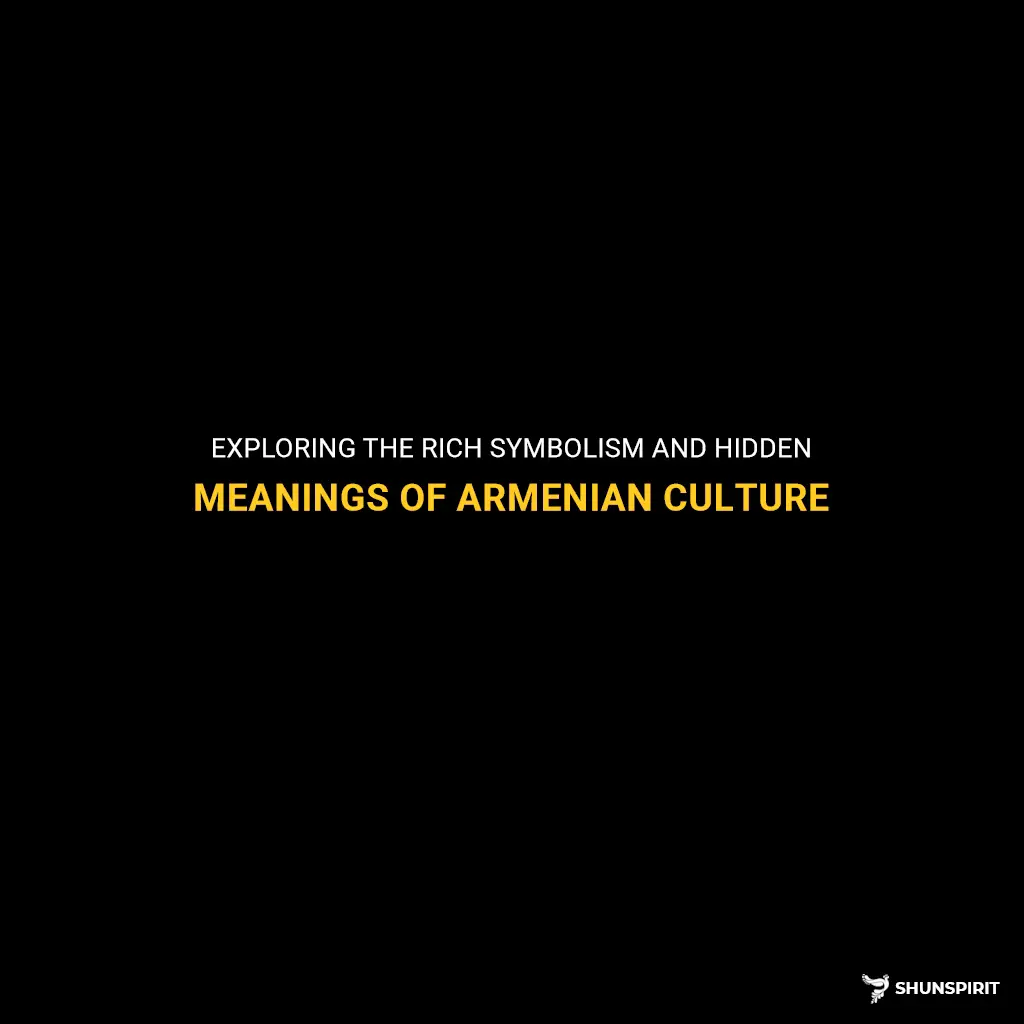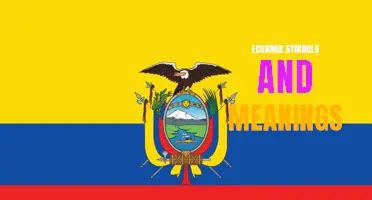
Armenian symbols are not just mere visual representations, but they hold profound meanings that have been passed down through generations. These symbols reflect the rich cultural heritage and deep spiritual beliefs of the Armenian people. From the intricate patterns of the famous Armenian carpets to the intricate designs carved into ancient Armenian stone crosses, every symbol tells a story and carries a unique significance. Whether it is the sacred Armenian eternity sign, the delicate flower motif of the pomegranate, or the powerful image of the Mount Ararat, each symbol encapsulates the essence of Armenian identity, history, and spirituality. Exploring the world of Armenian symbols is like stepping into a timeless journey that unravels the complex tapestry of Armenia's past, and allows us to embrace its vibrant traditions and age-old wisdom.
What You'll Learn
- What are some traditional Armenian symbols and their meanings?
- How have Armenian symbols and meanings changed over time?
- Are there any important religious symbols in Armenian culture?
- How are Armenian symbols used in art and design?
- Are there any specific colors or patterns associated with Armenian symbols and meanings?

What are some traditional Armenian symbols and their meanings?
Armenia, a country rich in history and culture, has a long tradition of using symbols to convey deep meanings and values. Here are some traditional Armenian symbols and their fascinating interpretations:
- The Armenian Cross (Khachkar): The Armenian Cross, known as Khachkar, is a unique symbol found throughout the country. It represents the Christian faith of Armenians and their rich cultural heritage. Each Khachkar is intricately carved with traditional patterns and symbols, and it serves as a memorial to commemorate significant events or individuals.
- The Armenian Alphabet: The Armenian Alphabet is not only a system of writing but also a symbol of national identity and pride. Developed in the 5th century by Mesrop Mashtots, it features unique characters with profound meanings. Each letter embodies a specific concept or word, making the Armenian Alphabet a powerful symbol of the intellect and culture of the Armenian people.
- Mount Ararat: Mount Ararat, the highest peak in modern-day Turkey, has significant symbolism for Armenians. According to the Bible, it is believed to be the resting place of Noah's Ark after the Great Flood. Mount Ararat represents the ancestral homeland and cultural heritage of Armenians, even though it is located outside the borders of present-day Armenia.
- Pomegranate: The pomegranate is a beloved symbol in Armenian culture, representing fertility, abundance, and good fortune. Its symbolic significance stems from its place in ancient mythology and folklore, where it is considered a sacred fruit. The pomegranate's rich red color also symbolizes vitality and the lifeblood of the Armenian people.
- Eternity Symbol (Arevakhach): The Eternity Symbol, known as Arevakhach, is a central motif in Armenian art and design. It is a stylized representation of a solar disk with equal-length Armenian crosses protruding from its rim. The symbol signifies eternity, the cycle of life, and the connection between heaven and earth.
- Dragon (Vishap): The image of the dragon, known as Vishap in Armenian folklore, embodies power, protection, and wisdom. It is often depicted as a mythical creature with a serpent-like body, wings, and a bird-like head. The Vishap symbolizes the strength and resilience of the Armenian people throughout history.
- Fertility Goddess (Anahit): Anahit, the ancient Armenian goddess of fertility and beauty, is an iconic symbol in Armenian culture. She represents femininity, motherhood, and the nurturing qualities associated with women. Anahit is often depicted as a radiant goddess adorned with elaborate headdresses and holding symbols of prosperity and abundance.
These traditional Armenian symbols not only serve as decorative motifs but also convey a deep sense of cultural identity, spirituality, and historical significance. They continue to be cherished by Armenians worldwide, reinforcing their connection to their heritage and ancestral homeland.
Exploring the Rich Symbolism and Meanings Behind Puerto Rican Culture
You may want to see also

How have Armenian symbols and meanings changed over time?
Armenian symbols and meanings have evolved greatly over time, as they have been influenced by various historical, cultural, and linguistic factors. These symbols hold deep significance for Armenians and reflect their rich heritage and identity. Let's explore some of the important Armenian symbols and how their meanings have changed through the ages.
- Armenian Cross (Khachkar): The Armenian cross, also known as Khachkar, is one of the most recognizable symbols of the Armenian culture. It is a stone-carved cross with intricate designs and inscriptions. Originally, the Armenian cross symbolized Christianity and represented the crucifixion of Jesus Christ. However, over time, the Armenian cross has also come to symbolize Armenian national identity and resilience in the face of adversity.
- Mount Ararat: Mount Ararat holds great significance in Armenian culture and mythology. According to the Bible, it is believed to be where Noah's Ark came to rest after the Great Flood. As the higher peak of Greater Ararat lies in modern-day Turkey, it has become a symbol of the Armenian people's longing for their ancestral lands. Mount Ararat represents the Armenian diaspora's connection to their homeland, and its image can be seen in various forms of Armenian art, literature, and architecture.
- Pomegranate: The pomegranate is a symbol deeply rooted in Armenian culture and folklore. It represents fertility, abundance, and prosperity. Traditionally, it was believed that the pomegranate's many seeds symbolized the Armenian population. Over time, the pomegranate motif has been incorporated into various forms of Armenian art, such as carpets, jewelry, and pottery, reflecting its enduring significance in Armenian society.
- Apricot: The apricot is considered the national fruit of Armenia and is a cherished symbol among Armenians. It represents Armenia's agricultural heritage and is often associated with fertility and good fortune. The apricot tree is also celebrated for its resilience, as it is one of the few fruit-bearing trees that can grow in Armenia's harsh climate. The apricot's symbolism extends beyond its culinary use, as it is incorporated into various art forms to express Armenian identity and pride.
- Alphabet (Armenian script): The Armenian script holds immense cultural and historical significance for Armenians. It was created in the 5th century by Saint Mesrop Mashtots and is one of the oldest alphabets in the world. The Armenian script represents the Armenian language, identity, and intellectual heritage. It has evolved over time, with various modifications and reforms, but its essence remains vital to Armenians' sense of cultural pride and heritage.
In conclusion, Armenian symbols and their meanings have evolved over time due to various historical, cultural, and linguistic influences. From the Armenian cross to Mount Ararat, and from the pomegranate to the apricot, these symbols reflect the rich heritage and identity of the Armenian people. They not only represent aspects of their belief systems and cultural practices but also embody their resilience, longing for homeland, and pride in their language and identity. Understanding the evolution of these symbols provides valuable insights into the history and culture of Armenia.
Decoding the Hidden Meanings of No Symbol Pokémon Cards
You may want to see also

Are there any important religious symbols in Armenian culture?
Armenia, with its rich history and deep religious roots, is home to various important religious symbols that carry great significance in the country's culture. These symbols have played a crucial role in shaping Armenian identity and conveying their religious beliefs. Let's explore some of the more prominent religious symbols in Armenian culture.
One of the most recognizable symbols is the Armenian Cross, also known as the "Khachkar." This unique cross combines elements of Christianity and Armenian heritage as it is carved out of stone and adorned with intricate patterns and symbols. Khachkars can be found in abundance throughout Armenia, with each one telling a different story or conveying a specific religious message. These crosses serve as reminders of the country's Christian faith and reflect the craftsmanship and artistic abilities of Armenian craftsmen.
Another important religious symbol in Armenian culture is the Mount Ararat. This majestic mountain holds significant religious and historical significance as it is believed to be the resting place of Noah's Ark following the biblical flood. Mount Ararat is deeply ingrained in the Armenian national consciousness and is considered a powerful symbol of Armenia's spiritual and national identity.
The Armenian Genocide Memorial Complex, commonly known as the Tsitsernakaberd, is another significant religious symbol in Armenian culture. This complex, located in Yerevan, serves as a memorial to the victims of the Armenian Genocide that occurred during World War I. The centerpiece of the complex is the Memorial Wall, which features twelve basalt slabs symbolizing the twelve provinces of historical Western Armenia, from which the Armenian people were forcibly deported and massacred. The Tsitsernakaberd is a place of remembrance and pilgrimage, reflecting the resilience and strength of the Armenian people in the face of tragedy.
Ancient Armenian petroglyphs are also considered sacred symbols in Armenian culture. These rock carvings, found throughout Armenia's mountains and landscapes, are believed to date back thousands of years and provide a glimpse into the country's prehistoric religious beliefs and traditions. The petroglyphs often depict animals, celestial bodies, and spiritual motifs, serving as a connection to the spiritual world for ancient Armenians.
The Armenian alphabet itself is viewed as a sacred symbol by many in Armenian culture. Developed in the early 5th century by Mesrob Mashtots, the Armenian alphabet played a significant role in the preservation and spread of Christian teachings in the region. It is considered a testament to the cultural and religious identity of the Armenian people and their commitment to their language and faith.
In conclusion, Armenian culture is replete with important religious symbols that reflect the deep spirituality and rich heritage of the Armenian people. From the Khachkar and Mount Ararat to the Tsitsernakaberd and ancient petroglyphs, each symbol carries immense significance and serves as a reminder of Armenia's religious beliefs, history, and national identity.
The Rich Symbolism and Deep Meanings of Hmong Symbols
You may want to see also

How are Armenian symbols used in art and design?
Armenian symbols have a rich history and are deeply rooted in the culture and identity of the Armenian people. These symbols are often used in art and design to celebrate and honor Armenian heritage, as well as to communicate various meanings and messages. They hold significance not only for Armenians but also for people who appreciate their beauty and symbolism.
One of the most well-known Armenian symbols is the Armenian eternity sign, also known as the "Arevakhach." This symbol consists of two interconnected infinity signs that form a cross-like shape. It represents eternal life, rebirth, and the eternal struggle of the Armenian people for survival. This symbol is often incorporated into jewelry, clothing, and other decorative items to represent Armenian identity and pride.
Another popular Armenian symbol is the "khachkar," which translates to "cross-stone" in English. Khachkars are intricately carved stone crosses that are typically found in Armenian churchyards and other sacred sites. These beautiful works of art often feature elaborate floral and geometric designs, as well as Armenian script and motifs. Khachkars are not only religious symbols but also serve as a way to commemorate important events, individuals, and places.
The Armenian alphabet, known as the "Mashtotsian script," is another significant symbol used in art and design. The alphabet consists of 39 letters and is considered as one of the most beautiful and unique scripts in the world. Various artists and designers incorporate Armenian script into their work, creating stunning calligraphy pieces, paintings, and sculptures. This not only showcases the beauty of the Armenian language but also adds a touch of cultural authenticity to the artwork.
Armenian rugs and carpets are also famous for their intricate designs and symbolism. These textiles often feature geometric patterns, floral motifs, and ancient Armenian symbols. The "Dragon rug" is perhaps the most famous example of Armenian carpet art and is known for its depiction of dragons, a symbol of protection and power in Armenian culture. Armenian rugs and carpets are highly sought after, not only for their beautiful aesthetic but also for the symbolism and cultural heritage they embody.
In addition to these specific symbols, Armenian art and design often incorporate elements inspired by nature, history, and religious beliefs. For example, paintings may feature landscapes depicting the stunning Mount Ararat, the traditional homeland of the Armenian people. Churches and religious structures are also a significant influence on Armenian art and design, with artists often drawing inspiration from the intricately detailed architecture and decorative elements found in these buildings.
Overall, Armenian symbols play a vital role in art and design, both within the Armenian community and beyond. Whether it is through the use of the eternity sign, khachkars, Armenian script, or other cultural motifs, these symbols help to showcase the richness of Armenian culture and history. They serve as a reminder of the resilience and enduring spirit of the Armenian people and act as a bridge between the past and the present. Through art and design, these symbols continue to be celebrated and appreciated, ensuring that Armenian heritage and identity are preserved for future generations.
Decoding the Meaning Behind TOSOT Air Conditioner Symbols: A Comprehensive Guide
You may want to see also

Are there any specific colors or patterns associated with Armenian symbols and meanings?
Armenian symbols have deep cultural and historical significance. They represent traditional values, beliefs, and narratives passed down through generations. One key aspect of these symbols is the colors and patterns associated with them. The colors and patterns used in Armenian symbols carry unique meanings and reflect the rich cultural heritage of the Armenian people.
Colors play an essential role in Armenian symbolism. Red, for example, symbolizes courage, strength, and Armenia's bloodshed in its fight for independence. It represents the resilience of the Armenian people and their ability to overcome adversity. Red is often used in symbols related to heroism, patriotism, and the Armenian flag itself.
Another color commonly used in Armenian symbols is blue. Blue represents spirituality, faith, and divinity. It symbolizes the connection between heaven and earth and is associated with the Armenian Apostolic Church, the national church of Armenia.
Gold is also a significant color in Armenian symbols. It represents wealth, prosperity, and abundance. Gold is often used in symbols associated with fertility, agriculture, and the prosperity of the Armenian people.
In addition to colors, patterns are also an integral part of Armenian symbolism. One well-known pattern is the Armenian eternity symbol, also known as the "Arevakhach." This symbol consists of interlocking double-ended infinity signs that form a unique, intricate design. It symbolizes eternity, the cycle of life, and the eternal nature of the Armenian people and their culture.
Another pattern commonly seen in Armenian symbols is the Armenian cross, also known as the "khachkar." The khachkar is a carved stone cross with intricate patterns and motifs. Each element of the cross has its own symbolical meaning, representing different aspects of Armenian heritage, faith, and history.
The use of colors and patterns in Armenian symbols allows for a deeper understanding and interpretation of their meanings. These symbols are an essential part of Armenian identity and continue to be cherished and celebrated today. They serve as a reminder of the rich cultural heritage and resilience of the Armenian people, as well as a connection to their historical roots.
Decoding the Meaning Behind PowerSchool Student Alert Symbols
You may want to see also
Frequently asked questions
The Armenian symbol Eternity, also known as the Arevakhach, represents the concept of eternal life and infinite existence. It is often depicted as a stylized version of a wheel or a circle with eight loops, symbolizing the eternal cycle of life and rebirth.
The Armenian symbol Mount Ararat is a representation of the mythical Mount Ararat, a significant landmark in Armenian culture. It symbolizes the ancestral home of the Armenian people, their connection to their land, and their collective identity as a nation.
The Armenian symbol Tricolor Flag, also known as the Armenian National Flag, is a representation of the Armenian nation and its struggle for independence. The flag features three horizontal bands of red, blue, and orange, symbolizing courage, loyalty, and creativity respectively. It is a powerful symbol of Armenian pride, resilience, and unity.







